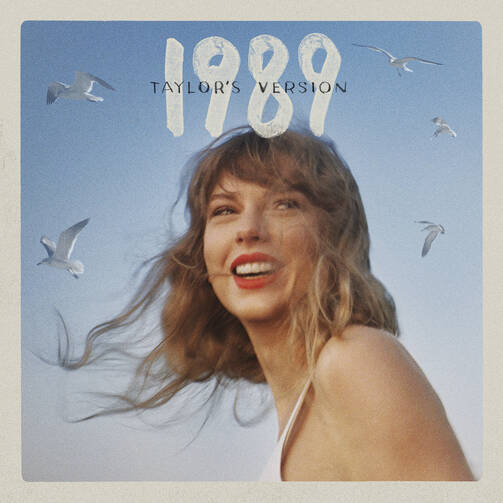Two days after I moved to New York in mid-August to start my O’Hare Fellowship at America, I felt a buzzing exhilaration. It was a propulsive feeling underneath my skin, telling me that I should go for a run for the first time in months. I turned on an album I have loved since I was 14 years old: Taylor Swift’s “1989.” I laced up my shoes and hit the ground running, the shimmering synths of her song “Welcome to New York” in my ears.
I wove through the commuters walking home through Columbus Circle and made my way to Central Park, thinking of the eighth-grade version of myself that heard this album for the first time in the suburbs of Chicago. I had dreamed of moving to New York to become a Broadway star, filling three-ring binders and Pinterest boards with photos of the city and Swift lyrics like “Everybody here wanted something more/ Searching for a sound we haven’t heard before/ And it said welcome to New York, it’s been waiting for you.”
I am 23 now, and though I have abandoned those delusions of grandeur about my singing voice, I still found myself here, running two blocks from my apartment to Central Park on a muggy August day.
Taylor Swift revisits the recording that transformed her from a star into a supernova, reflecting with joyful grace on the woman she was still becoming.
“Everybody here was someone else before,” Swift sang through my AirPods, and I thought of the little girl I was when this album came out; she was someone else, of course, but she was as near to me as the hot blood in my face as I ran under one of Central Park’s many arches.
Since 2021, Taylor Swift has been re-recording her first six albums, including “1989.” She has undertaken this project to regain control of her master recordings after they were purchased without her consent in 2019, and to advocate for the rights of artists to own their work. In revisiting her earlier work, Taylor Swift draws near to all of the past versions of herself—her “Eras,” so to speak. Just as I looked back at the young version of myself as I ran through the park, she returns to the version of herself most similar to who I am now: a 24-year-old who had just moved to New York City. With her release of the album “1989 (Taylor’s Version)”, Swift revisits the recording that transformed her from a star into a supernova, reflecting with joyful grace on the woman she was still becoming.
“1989” was always going to be a challenge to reproduce in all of its intricate pop production. On the whole, the new album is remarkably faithful to its source material. It is an especially impressive feat considering that it was produced without Max Martin, the storied pop producer who produced nine of the original album’s fifteen tracks, along with production by Swift herself and Swedish record producer Shellback. (Shellback returned for the new album only to produce “Wildest Dreams.”) Instead, Martin’s tracks are re-created on the new album with Christopher Rowe, who has been Swift’s main collaborator throughout the re-recording process.
On most tracks of “1989 (Taylor’s Version),” the synths are shinier, the snares are sharper and Swift’s vocal performance has benefitted from the years of training she has undergone since 2014. Songs like “All You Had To Do Was Stay,” “Wonderland” and “I Know Places” benefit immensely from Swift’s improved vocal control and richer sound, allowing the choruses to soar higher than ever before. These songs make a solid case for the underlying premise of the re-recording project: Not only can Taylor Swift make a generation-defining pop album once; she can do it again, and better.
Not only can Taylor Swift make a generation-defining pop album once; she can do it again, and better.
However, some of the songs do lose a bit of their luster. “Style,” a propulsive, perfect pop song, suffers from somewhat anemic sound mixing—it is quieter, less upbeat, and the electric guitar lick is muffled. “New Romantics,” a triumphant embrace of Swift’s youth and finding joy in friendship amid the intense scrutiny she faced, loses its frenetic, exhilarated tone. As a result, it is less convincing when she proclaims, “I could build a castle out of all the bricks they threw at me,” even though the castle Swift went on to build is formidable.
Still, most of the tracks on the new album are either indistinguishable from or even stronger than the songs from the original “1989.” The song “Out Of The Woods,” an anxiety-laden anthem set over looping drums, especially benefits from Swift’s improved voice. When Swift belts, “Oh, I remember” at the peak of the song’s outro, there is none of the thinness and desperation present in the original version. Instead, on this version, she sounds stronger and more self-assured in both her vocal ability and her staying power as an artist.
Nevertheless, on this new album it is evident that she remembers what it was like to make the original recording; what it was like to be Taylor Swift in 2014, as “the only one who really knows that body of work.” She inhabits those feelings with the clarity and grace that only time can provide.
The original precarity expressed in “Out Of The Woods” can serve as a window into Swift’s search for solid ground during this era. After Taylor Swift won the Album of the Year award at the 2016 Grammy Awards for “1989,” making her the first woman to ever win the top award twice, she reflected in a documentary, “You get to the mountaintop, and you look around, and you’re like, ‘Oh God, what now?’”
It is a challenge, and I would argue a deeply spiritual one, to look back on old versions of yourself without cringing.
Now we know, she would only climb higher—she is one of only four performers to win the Album of the Year Grammy three times, alongside Stevie Wonder, Paul Simon and Frank Sinatra. But it was not a wild supposition to assume she had reached her peak. Swift was everywhere, perhaps over-exposed, and learning in real-time how the culture sinks its claws into female artists no matter how carefully they craft their image.
The new “1989” also includes five previously unreleased “From The Vault” tracks in which Swift gives greater insight into how she felt about her public image back in 2014. “Slut!,” a dreamy, melancholy synth track, explores Swift’s loss of control over the prevailing media narrative that nine years ago deemed her a histrionic, vengeful serial dater. In a voice memo released on Tumblr on Oct. 27, she explains that, in “Slut!”, she “cheekily plays on the discussions at that time in my life around my dating life” much like she did on her track “Blank Space.” That song ultimately made the original “1989” album and topped U.S. charts for seven weeks in 2014. Swift was right to pick “Blank Space,” a much more clever song than “Slut!” for the 2014 release, but the pensive, defeatist track gives emotional depth to the more winking, sly nods towards her image on the rest of “1989 (Taylor’s Version).”
The production of the vault tracks is often unambitious and derivative of other collaborations between Swift and her longtime producer Jack Antonoff. They are well-made songs, but they fail to showcase Swift’s well-charted ability to experiment with sound. (See the uninspiring lyricism of “Suburban Legends,” a track which could have been left on the cutting room floor of any album by Antonoff’s band, Bleachers).
The main value of the vault songs is in how they further complicate the triumphant, upbeat image Swift put forth on the original “1989.” The hook of “Say Don’t Go,” which declares, “I would stay forever if you say, ‘Don’t go,’” stands in sharp contrast to Swift’s proclamation that “People like me are gone forever when you say goodbye” from the track “All You Had To Do Was Stay.”
Are the people we once were ever really gone? Is it ever over? Perhaps we never actually reinvent ourselves.
Another vault track, “Now That We Don’t Talk,” a breakup song fit to strut to, looks back at a romantic relationship that took far more from her than it ever gave. It closes with Swift reflecting that, “The only way back to my dignity was to turn into a shrouded mystery.” She is reminding listeners that even for a pop star known for marketing herself in sharply-defined, distinct “Eras,” heartbreak has a way of leaving a person unmoored and unsure of who they once were.
Next to the baptismal imagery on the soft-synth ballad, “Clean,” we see how Swift is strengthened by each wound she incurs along the way. “Just because you’re clean don’t mean you don’t miss it,” she admits. The scars will remain, but they have become a part of her, and in this re-recording project we see the grueling lengths Taylor Swift will go to to take ownership of her work and herself.
On the last of the vault tracks, “Is It Over Now?,” Swift looks back on a messy, undefined relationship, belting out the vault’s catchiest hook: “Was it over then, and is it over now?” Even if the song is about an ill-advised love affair, I could not help but think of this in the meta-textual context of Swift re-recording her past albums. Swift has lamented the pressure incumbent upon female artists to constantly reinvent themselves, and her re-recordings are a radical means of pushing back against this. Through the project of fully inhabiting the past versions of herself, Swift asks listeners: Are the people we once were ever really gone? Is it ever over? Perhaps instead, we never actually reinvent ourselves. We just find new ways to incorporate our past into our present identity, as we become more ourselves each day.
It has been a long time since I was that 14-year-old girl listening to Taylor Swift in my bedroom in Western Springs, Illinois, just as it’s been a long time since Taylor Swift was the 24-year-old who recorded this album. So often we wish to escape ourselves, to run from our past in all of its embarrassing detail. (There’s a reason my Pinterest from back then no longer exists.)
It is a challenge, and I would argue a deeply spiritual one, to look back on old versions of yourself without cringing—it demands profound grace and self-assurance. In “1989 (Taylor’s Version),” Swift looks back on who she was in 2014, in all its complexity, with love. In doing so she provides profound insight into who she was at the time.
I first listened to “1989 (Taylor’s Version)” three months after that humid August day in Central Park. This time I was not running. I wanted to stay exactly where I was, snuggled in bed with my three best friends from college, reunited in Boston after our graduation in May. We shared with each other what this album meant to us in 2014. One friend, Claire, reflected on what a gift it was that this old album gets to be made new again for all of us to re-discover as more mature people—and to get to do so together.
There is so much to be gained from looking back at who we once were: We gain clarity on our desires, our relationships and the people we are still striving to become. In her re-recording of “1989,” Taylor Swift reminds us that those old versions of ourselves are never far. We can always run toward them if we want to.








